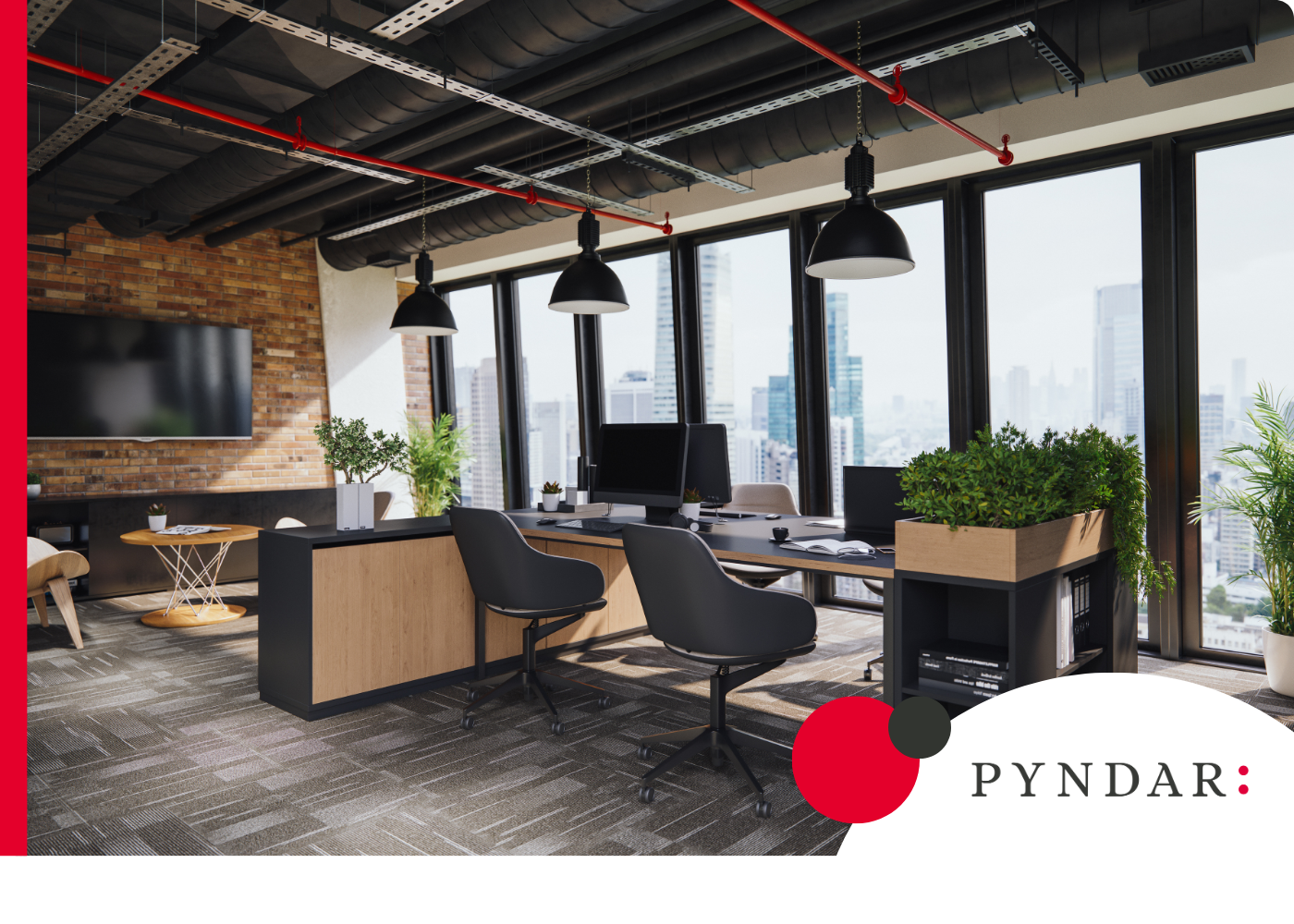Getting the balance right between office presence and remote working: How facilities management can support your business
The hybrid working model – where individuals divide their time between the office and home – has become a permanent fixture of modern business practice, reshaping the purpose and design of workplaces. According to Coldwell Banker Richard Ellis (CBRE) research, 80% of office occupiers have adopted and will sustain hybrid work policies.
However, achieving the right balance between office and remote working presents unique challenges. Businesses must now create compelling reasons for people to visit their offices, ensuring that when they do so productivity, engagement and well-being are fostered.
This is where a facilities management (FM) partner such as Pyndar can make a critical difference, helping businesses create environments which support both staff needs and business objectives.
How workplaces have changed
The role of the office has evolved significantly in recent years. Research by the Office for National Statistics (ONS) has identified that 28% of working adults in Great Britain are hybrid working. With remote working proving effective for individuals, many businesses have reimagined their office spaces to prioritise collaboration and social interaction.
Key changes include:
- Smaller office footprints: With more people working remotely for part of the week, businesses are downsizing their office spaces, focusing on multi-use areas rather than rows of desks.
- More collaboration spaces: Offices are being designed to facilitate teamwork, featuring open-plan layouts, breakout areas and informal meeting spaces.
- Flexible working environments: Hot-desking, shared spaces and agile seating arrangements allow people to use offices in a way that suits their work style.
- Stronger focus on staff experience: Employers are investing in workplace amenities, wellness areas and community-building initiatives to make office working a more engaging and worthwhile experience.
Why office presence still matters
Remote working has its advantages. According to ONS data workers report several benefits. These include improved work-life balance (reported by 78%), fewer distractions (reported by 53%), and improved well-being (reported by 47%). However, the office remains essential to business operations, with further CBRE research showing that 90% of organisations want their staff in the office at least two days per week.
There are several advantages to maintaining a strong office presence. Some of the best ideas emerge from spontaneous conversations and face-to-face interactions that virtual meetings cannot replicate. Offices also provide a sense of belonging, which strengthens workplace culture and fosters social connections, and a well designed office environment (for example, offering ergonomic workspaces) supports employee well-being. The above-mentioned ONS dataset also found that 48% of those surveyed felt it was harder to work with others from home; 15% also reported it was harder to think of new ideas when home working.
In addition, senior managers also benefit from direct interaction with teams, which helps ensure alignment with company goals and values.
The challenges of hybrid working
Balancing office and remote work presents several challenges for businesses:
- Encouraging office attendance: Your people need clear incentives to visit the office beyond just having a desk. The office must be a place that supports collaboration, social interaction, and a sense of purpose.
- Optimising office space: With fluctuating attendance businesses must ensure office space is used effectively, avoiding overcrowding or underutilisation. Companies must accommodate varying staff numbers whilst ensuring productivity and maintaining a ‘connected’ workplace (if staff are too widely dispersed in an office, it can lead to a sense of disconnection, diminishing opportunities for spontaneous communication and teamwork that are essential for a thriving company culture).
- Maintaining hygiene and safety: Offices must be clean and safe, reassuring your people that their well-being is a priority.
- Sustaining productivity and engagement: While some tasks are best suited to remote work, others require in-person collaboration. Striking the right balance is crucial for maintaining productivity and morale.
How facilities management supports hybrid work
Facilities management plays a key role in encouraging people to come into the office, and creating spaces that cater to the hybrid working model. A well maintained, thoughtfully designed office enhances your team’s experience, ensuring they feel comfortable, motivated and engaged when they choose to work at the office.
Creating an office worth commuting to
People are more motivated to come into the office if it offers benefits they cannot get at home. Companies can create attractive and functional workspaces by:
- Ensuring a comfortable environment: Providing ergonomic furniture, and monitoring for good air quality and natural light to enhance well-being.
- Enhancing collaboration spaces: Designing breakout areas, meeting rooms and informal spaces to support teamwork and creativity.
- Upgrading technology: Ensuring easy connectivity, video conferencing facilities and shared digital tools to integrate remote and in-office work effectively.
- Introducing hospitality-inspired spaces: Creating inviting lounges, well-stocked refreshment areas and quiet relaxation zones to make the office feel more welcoming.
- Facilitating social engagement: Hosting workplace events, wellness programmes, and team-building activities to foster a sense of community and excitement about being in the office.
Prioritising hygiene and safety
A clean and safe office is essential to staff confidence in hybrid working. Facilities management teams ensure:
- Regular cleaning schedules: High-traffic areas such as kitchens, meeting rooms and washrooms, are maintained to high standards.
- Hygiene practices: Availability of hand sanitising stations and frequent sanitisation of shared surfaces.
- Health-conscious design: Proper ventilation, thoughtfully spaced seating arrangements, and flexible layouts to accommodate different working styles.
Managing space efficiently
As staff attendance fluctuates, businesses must make the best use of their office space to ensure efficiency and sustainability. Facilities management partners can help by monitoring occupancy levels and adjusting layouts in order to allocate resources effectively. Sustainable solutions, such as adjusting lighting, heating, and air conditioning based on real-time occupancy data, help reduce energy consumption.
The Pyndar approach: A trusted partner on your journey
Selecting the right FM provider is a critical decision for any business. The best such can transform the workplace experience, increasing staff productivity and morale while supporting commercial and environmental goals.
We work closely with businesses to understand their needs, helping them create workplaces that align with their vision for hybrid work. We are more than a service provider: we are a trusted partner, supporting companies in adapting to workplace changes, and ensuring their office environments remain engaging, functional, and future-ready.
Hybrid working is here to stay, and businesses must strike the right balance between remote work and office presence. By working with a trusted FM partner like Pyndar, businesses can ensure their offices remain functional, vibrant, and supportive of staff collaboration and well-being.
To learn more about how Pyndar can support your hybrid working strategy, get in touch today. Call 020 3488 1280, e-mail transform@pyndar.uk or visit our contact page.
Trends & Insights
Why sustainability starts and ends with your staff
More companies – and their investors – are prioritising environmental, social and governance (ESG) practices, not least as t ... Read more
Why long-term facilities management partnerships deliver more
The best facilities management (FM) requires dedication, precision, an ability to anticipate change, and a commitment to serv ... Read more
Time for a new facilities management provider? Make the process as seamless as possible
The decision to work with a new facilities management (FM) supplier is often driven by an organisation’s strategic objectives ... Read more



